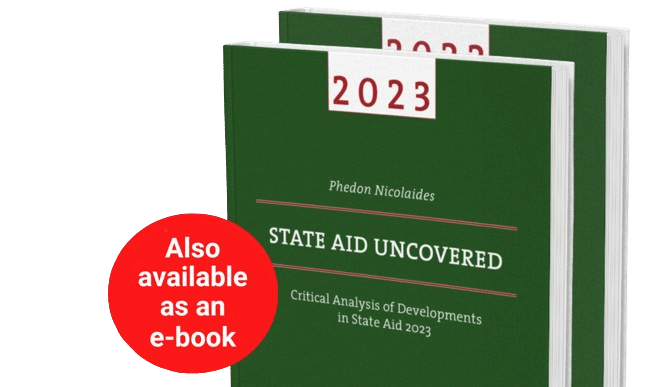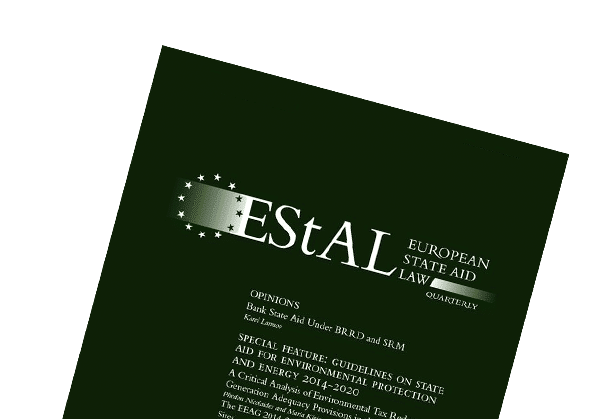
There is a significant variation across Member States in terms of the number of aid measures as well as the amount of aid.
Introduction
On 17 December 2020, the European Parliament published a report evaluating the impact of State aid to combat covid-19.[1] The report was requested by the committee responsible for economic policy. The report is probably the first independent attempt to examine the effect of the huge amounts of public money that have been pumped into the European economy.
It highlights the significant differences across Member States with respect to the number of State aid measures, as well as the amount of aid, both in absolute and relative terms. Given these differences, the report warns of possibly substantial distortions of competition.
Objectives of the report
The report tries to answer “the question of whether the current EU State aid policy and practices are appropriate given the challenges caused by the COVID-19 crisis.” [p.10] It seeks “to answer that question by focusing on potential distortions that could result from recently approved State aid provisions.” [p.10]
The report, first, examines the economic impact of covid-19 on EU Member States. All Member States have suffered. GDP growth in the first half of 2020 declined by more than 10%. But some have suffered more than others. The reasons for the uneven impact of covid-19 seem to be i) differences in the number of covid cases experienced by each country, ii) the bigger disruption of travel and tourism which has affected more tourism-dependent countries, and iii) distinct policy responses.
Then the report recounts the situation that led to the adoption of the Temporary Framework [TF] by the European Commission in March 2020. It reviews briefly the provisions of the TF, the Treaty articles on which they are legally based, the conditions for the granting of the various forms of aid [grants, loans, guarantees, capital injections, tax exemptions, etc], the maximum allowable ceilings and eligibility criteria.
Because the TF has basically relaxed State aid discipline, the report identifies certain risks in the current measures to combat the effects of the pandemic. First, it argues that “the policy principles are not necessarily correctly applied in practice.” [p.18] It is not clear whether this is a policy error at EU level or a problem at national level caused by faulty implementation by Member States.
Second, “various conditions are defined in an ad hoc way. Though this is a normal State aid technique, ad hoc thresholds may raise concerns about distortion of competition.” [p.18] Indeed all thresholds are to some extent arbitrary. But as the report itself acknowledges, given the suddenness of the pandemic, the Commission could not to do otherwise. The report, nonetheless, urges revision in the future after evaluation. Since, however, the TF will expire in six months’ time, it may not be worth carrying out such an evaluation.
Third, the report widens the scope of its review to argue that “the effectiveness of the EU State aid policy crucially depends on the ex-post monitoring of approved State aid measures. The current procedures (submission of an annual report, publication of effective aid provided beyond certain thresholds, listing of measures put in place, detailed records of aid provided) are vague. It is far from certain that these procedures will be sufficient to allow for correct monitoring and eventually for appropriate actions in case of violations.” [p.18] For sure reporting and publication of data do not replace a proper evaluation of the effectiveness of State aid measures. But the statement quoted above seems to conflate the effectiveness of State aid with legal compliance. Reporting and publication are good instruments for detecting violations, but the ex-post monitoring is not limited to what Member States report. Nor, is the detection of “violations” wholly dependent on reporting and publications. The Commission receives many complaints each year from competitors which provide useful information.
Fourth, the report claims that “the current State aid principles and practices are mainly defensive in nature, i.e. they are designed to avoid competition distortions and do not aim at achieving or facilitating other policy objectives. […] The current EU State aid policy also fails to boost European firms’ global competitiveness. Apart from a more lenient approach to trade credit insurance, none of the conditions put forward aims to strengthen European firms’ position in global markets.” [pp.18-19] This is surprising claim. Given the very wide scope of Article 107(3)(c), it is difficult to understand how State aid policy prevents the achievement of other objectives, especially given that the choice of policy objectives is determined by Member States. The report later returns to this theme and its findings will be considered in more detail towards the end of this article.
Impact assessment
The main part of the report is devoted to an “impact assessment” of the State aid measures to counteract the effect of covid-19. The measures which are taken into account are those approved in the period from March to October 2020. The report examines about 300 cases. The current number of cases is close to 400.
An impact assessment only six months after the first case of State aid was authorised is both an ambitious and difficult task. It is a difficult task because of i) the variety of the forms of State aid, ii) the ongoing deployment of many measures and iii) incomplete information on the amount of money actually spent. [p.20]
But it also a too ambitious task because of the many limitations and constraints it faces. In fact, the analysis that is undertaken, although very useful and illuminating, is not a true impact assessment for the simple reason that it does not establish a counterfactual – what would have happened without the aid. Given that covid-19 aid has been available to all economic sectors, it would be technically difficult to isolate its effect, as there are likely to exist only few non-aided but similar companies in the same or similar sector to form a credible comparator. One may try to compare the performance of, say, Ryanair [which allegedly has received no aid] to airBaltic or Lufthansa, but the validity of the comparison will depend on the extent of their similarity not only in terms of size but also in terms of business model. And even if one finds similar pairs of aided and unaided companies, would the results be generalizable? Perhaps one can overcome this problem by examining differences across Member States, of which there are many as we will see below. But comparing companies in different legal settings and economic environments creates pitfalls of its own.
Large differences between Member States
Most of the measures adopted by Member States offered grants. The second most popular instrument was guarantees. Loans and capital injections were the least used instruments. [p.28]
Most measures were open to companies of all sizes in all sectors. Some measures targeted SMEs and/or specific sectors such as tourism, air and land transport, agriculture or culture. [pp.29-30]
The report notes the significant variation in the number and size of the measures adopted by Member States. Some Member States have opted for a few large programmes, covering the whole economy while others have implemented more measures with smaller budgets targeting specific sectors. [p.21] Aid measures range from EUR 10 million to EUR 500 billion. About half of the measures have budgets of less than EUR 100 million.
It is not easy to say which approach is better: Few but big or small but more? There is probably a trade-off between the lower administrative burden of operating fewer schemes and the better targeting of more but specialised schemes. [p.22]
According to data presented by DG Competition at a Lexxion event that was held at the end of November 2020, a few large Member States [e.g. Germany, France, Italy] accounted for more than 65% of total aid in the EU in terms of budgeted schemes. However, the uptake from approved budgets was only around 20% at that time. Also there was great variability in terms of aid as a percentage of the national economy, ranging from 1% to 16%. Again some of the larger Member States granted relatively more aid than smaller Member States.
The report identifies a discrepancy between the damage caused by covid-19, in terms of loss of GDP, and the amount of aid granted. Although for the EU28 as a whole there was a mild correlation between GDP loss and amount of State aid, some Member States [DE, DK, EE, FI, NL, SE, SI, SK] granted more aid, relative to others, than the damage they suffered. [p.27]
In this connection, the report claims that “currently, the EU state policy rules are unclear as to how the European Commission deals with cases depending on their size”, but provides no evidence to back up that claim. [p.22] The GBER lays down individual notification thresholds and cases which are individually notified are subject to detailed assessment according to the criteria in the various guidelines. So it is clear how notified measures are treated.
However, it is true that the TF does not modulate the assessment of covid-19 related measures according to the size of their budget. It also appears from the longer period between notification and approval that large measures that target specific companies [e.g. Lufthansa, KLM] are scrutinised more closely by the Commission. Although the TF does not lay down any explicit conditions regarding such targeted measures, it should not come as a surprise to any Member State that the Commission would be more cautious in approving them and perhaps asking for modifications to mitigate their adverse effect on competition.
“Defensive” v “offensive” measures
After the review of State aid cases, the report identifies what it calls “defensive” and “offensive” features. “Defensive features fit into the general objective of maintaining the level playing field in the EU single market, while offensive features reflect to what extent recent State aid cases support broader policy objectives.” [p.34]
The report identifies the following “defensive feature”: “In general, European Commission decisions on state case measures are very defensively formulated. First, many COVID-19-related State aid cases focus explicitly on export-oriented companies or on internationally active firms.” [p.34] The report considers State aid to this kind of firms to be distortionary, causing “unfair competition”. However, the definition of export-oriented firms is very loose so that many firms in many sectors can qualify for aid, a fact which blunts the distortion caused by the aid. At the same time the report concedes that “nevertheless, from the European Commission documentation, it becomes clear that these potential competition distortion concerns are taken seriously. […] the European Commission States that the provided support ‘will not take the form of export aid contingent on export activities’”. [p.34]
With respect to “offensive features”, the report starts with the following two statements: “One could wonder why the State aid schemes are not more proactively used to support European companies in their strategies to access non-EU markets.” And, “though export-orientation may be market distortive when exports are directed to the EU single market, it would actually be a major plus when directed to global markets.” [p.35] These two statements, first, contradict what was labelled “defensive” earlier. Second, they ignore the WTO prohibition of export subsidies. Third, they disregard the distortion caused by European companies competing against each other in foreign markets. Fourth, they provide no further proof to back up the statement that State aid schemes are not more proactively used. Perhaps the report considers that in the absence of specific obligations imposed by Member States or the Commission, beneficiary companies would not use aid to improve their export strategies. But similarly to the fact that absence of proof of innocence does not prove guilt, absence of positive evidence how the aid is actually deployed, may not lead to the presumption that beneficiary companies use the aid “defensively”. [p.35]
The report also comments positively on aid for R&D on covid-19 but criticises the absence of links to the green and digital economy. [p.35] Given that the primary impact of the pandemic was to starve companies of liquidity, it is reasonable that the initial policy response was to provide liquidity without any strings attached. A later amendment to the TF to cover recapitalisation measures did not prevent recipient companies from investing in green or digital technologies if they would consider that kind of investment to be necessary to their survival.
Links to fiscal policy
In its last section the report observes, correctly, that the fiscal stance of Member States differs and that Member States have already incurred large, but varying, deficits that may affect competition in the future.
Recommendations
The report concludes with the following recommendations, as stated on pp.38-40:
- “Enhanced transparency in the evaluation” of State aid.
- A “better and more systemic reporting “of State aid.
- Consideration of previous cases submitted by the same Member State as well as similar cases submitted by other Member States in assessing new cases.
- “More differentiated treatment” between smaller and larger measures.
- More detailed assessment of large, “umbrella” [multi-sector] schemes.
- “Closer monitoring” of the implementation of State aid measures.
- “Enhanced screening and follow-up” of aid to specific sectors [e.g. aviation].
- “More cautious” treatment of State aid to firms or sectors with “intense” intra-EU trade.
- More aid in favour of SMEs and less in favour of large enterprises.
- A “strict follow-up” on the eventual use of the guarantees.
- Consideration of the substantial variation in State aid intensity and possible dis-proportional aid in relation to the economic damage caused by covid-19.
- “More assertive” State aid rules to “enhance European exporters’ competitiveness on global markets”.
- “More attention to green and digital transformation in setting the conditions for future State aid”.
Conclusions
This is a useful report in revealing the variation in State aid measures to combat covid-19 across the EU. Some of its recommendations are pretty reasonable. More transparency, closer monitoring and enhanced screening are clearly welcome. Certainly, the Commission should pay more attention to the link between the amount of aid and the damage caused by covid-19 and the cumulative effect of the various aid schemes.
However, it suffers from a presentational and a substantive drawback. First, it is not always clear whether it refers exclusively to aid measures based on the TF or whether it also concerns measures designed and implemented according to the “normal” State aid rules. Some of the recommendations appear to be broader than the scope of the TF. Yet they do not consider the “normal” rules, nor do they indicate how the “normal” rules may be defective or incomplete.
Second, it does not take into account possible counter-arguments to its recommendations and possible unwanted side-effects if the recommendations would actually be adopted and applied.
[1] Jan van Hove, Impact of state aid on competition and competitiveness during the COVID-19 pandemic: an early assessment, European Parliament, December 2020. It can be accessed at:
http://www.europarl.europa.eu/RegData/etudes/STUD/2020/658214/IPOL_STU(2020)658214_EN.pdf
Photo by Markus Winkler on Pixabay


